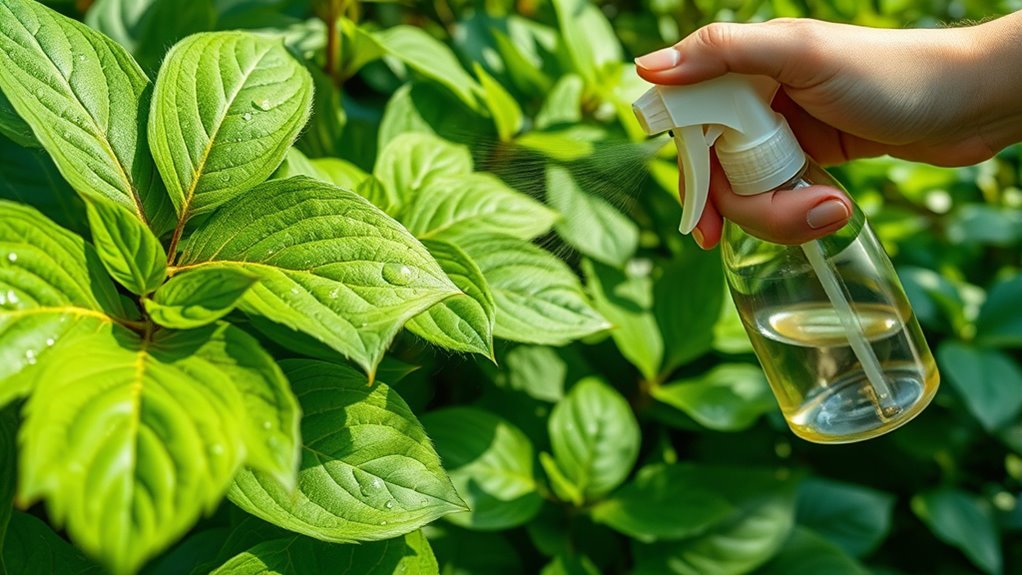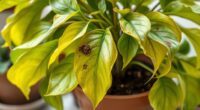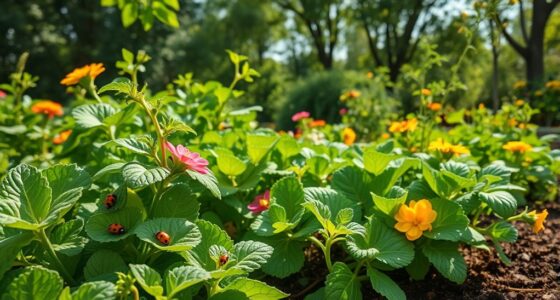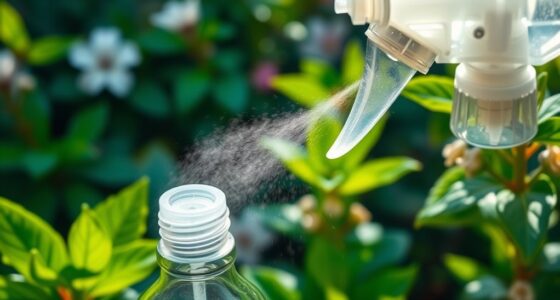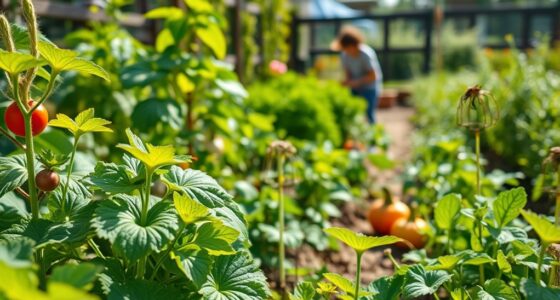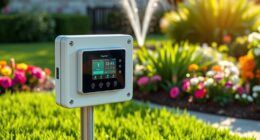To safely use neem oil on your plants, mix it with water and a few drops of mild soap, following the label’s recommended ratio. Spray thoroughly during early morning or late afternoon, focusing on all surfaces and undersides of leaves. Wear gloves and avoid applying during peak heat or bloom times to prevent damage and protect beneficial insects. For effective, eco-friendly pest control, follow these tips and discover more ways to keep your plants healthy.
Key Takeaways
- Mix neem oil with water and a mild soap, using 1-2 tablespoons per gallon, before applying to plants.
- Apply during early morning or late afternoon to prevent leaf burn and maximize absorption.
- Spray thoroughly on all plant surfaces, including undersides of leaves, for effective pest control.
- Use protective gear like gloves and eyewear, and avoid spraying during peak heat or bloom times.
- Repeat treatment every 7 to 14 days for optimal pest and fungal prevention, following product instructions.
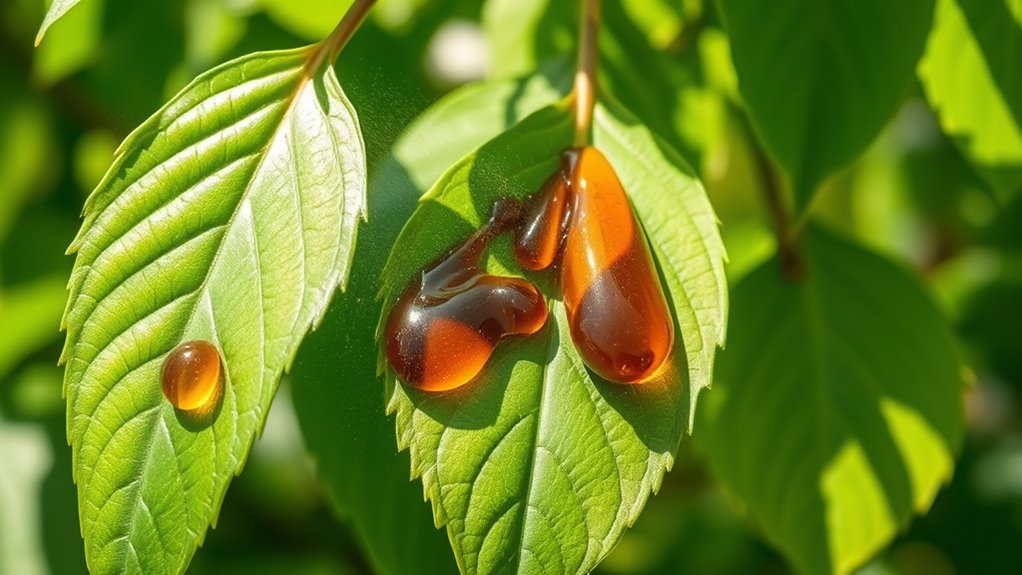
Neem oil is a popular natural solution for protecting your plants from pests and diseases, and when used correctly, it’s safe for both your plants and the environment. If you’re into organic gardening, you’ll appreciate how neem oil offers an effective pest control method without resorting to harsh chemicals. It’s derived from the seeds of the neem tree, which has been used for centuries in traditional farming practices to naturally combat insects and fungal issues.
Neem oil offers a safe, natural pest control solution derived from neem tree seeds.
When you decide to use neem oil, it’s important to follow proper application techniques to ensure safety and effectiveness. Start by mixing the oil with water and a small amount of mild soap, which helps the solution adhere to plant surfaces. Usually, a ratio of one to two tablespoons of neem oil per gallon of water suffices, but always check the instructions on your specific product. Applying the mixture during early morning or late afternoon prevents leaf burn and minimizes stress on your plants. Avoid spraying in the heat of midday, as the oil can cause sunburn or damage to the foliage.
You’ll want to spray the solution thoroughly on all plant surfaces, including undersides of leaves where pests often hide. Consistent application, every 7 to 14 days, can keep pest populations in check and prevent infestations from worsening. Keep in mind, neem oil isn’t a quick fix; it works by disrupting the life cycle of pests and fungi, so patience and regular treatment are key. Additionally, neem oil acts as a repellant, making your plants less attractive to pests over time.
Safety is paramount when using neem oil. Wear gloves and protective eyewear to prevent skin or eye irritation, especially if you’re applying it in concentrated form. Be cautious with application around beneficial insects like bees and ladybugs—avoid spraying during bloom times if possible. Furthermore, neem oil is biodegradable and breaks down quickly in the environment, aligning perfectly with the principles of organic gardening. This means you can protect your plants without worrying about long-term chemical buildup in the soil or water sources.
Frequently Asked Questions
Can Neem Oil Harm Beneficial Insects?
You might wonder if neem oil impact harms beneficial insects. While neem oil is effective against pests, it can also influence beneficial insects if applied directly or during their active hours. To protect beneficial insect populations, you should target applications carefully, preferably early in the morning or late evening. Proper use ensures beneficial insect protection while still controlling pests, balancing your garden’s health and environmental safety.
How Often Should I Apply Neem Oil?
Think of it as walking a tightrope—you don’t want to overdo it. For neem oil, apply every 7 to 14 days, depending on pest resistance and the severity of the problem. Proper application timing is key; apply in the early morning or late evening to avoid harming beneficial insects. Consistent use helps prevent pests while minimizing the risk of resistance and keeping your plants healthy.
Is Neem Oil Safe for Edible Plants?
You’re wondering if neem oil is safe for edible plants, and it’s good to be cautious. Neem oil toxicity is generally low when used properly, making it safe for edible plant safety. Just make sure to apply it during the early morning or late evening, avoid excess, and rinse your plants thoroughly before harvest. Following these guidelines minimizes risks and keeps your plants healthy without compromising safety.
What Are Signs of Neem Oil Overuse?
You might notice plant sensitivity signs, like leaf curling, yellowing, or wilting, if you overuse neem oil. Following dosage guidelines is essential—using too much can cause damage. Keep an eye on your plants after spraying, and if you see these symptoms, reduce or stop application. Proper application helps prevent overuse, ensuring your plants stay healthy without suffering from neem oil toxicity.
Can Neem Oil Be Used Indoors Safely?
Think of neem oil as a gentle guardian, quietly protecting your indoor sanctuary. You can safely use it for indoor pest control, but always dilute it properly and ventilate your space afterward. This guarantees your plant health management stays effective without overwhelming your plants or your home. With care, neem oil becomes a trustworthy ally, maintaining the delicate balance of your indoor garden while warding off pests naturally.
Conclusion
Remember, when used correctly, neem oil is a safe and effective way to protect your plants. Some worry about potential harm to beneficial insects, but applying it during early morning or late evening minimizes this risk. By following the proper directions, you can enjoy healthy, pest-free plants without compromising your garden’s ecosystem. So go ahead—use neem oil confidently, knowing you’re taking a natural, responsible step toward nurturing your garden sustainably.
